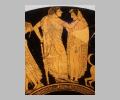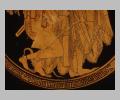| Collection: | Berlin, Antikenmuseen |
| Summary: | Interior: Peleus and Thetis. Side A: youths and boys. Side B: youths and girls. |
| Ware: | Attic Red Figure |
| Painter: | Signed by Peithinos |
| Context: | From Vulci |
| Date: | ca. 500 BC |
| Dimensions: | H. 13.0 cm., d. 34.0 cm. |
| Primary Citation: | |
| Shape: | Kylix |
| Beazley Number: | 200977 |
| Region: | Etruria |
| Period: | Archaic |
Condition:
The kylix is in good condition, although two of the figures on side B have suffered from encrustation and discoloration.
Decoration Description:
Interior: Peleus and Thetis. Peleus struggles with Thetis. Peleus has captured Thetis in mid-stride. In a crouch, he has locked his arms around her waist from behind (his locked hands stylized to form a meander). Thetis' transformative response is seen in the snakes wrapped around her and Peleus' arms and Peleus' leg, and the small lion just released from her right hand. Peleus is wearing a short chiton decorated with small crosses and an ankle band, and a sheathed sword hangs at his waist. His hair is worn in rows of curls over his forehead (painted in added white), with the straight, long hair in back flipped up and held it in place with a thin, black fillet. Thetis wears a long chiton decorated with small crosses, a mantle with dot-rosettes, a hairband decorated with a meander, armbands and round earrings. She holds another garment in her left hand.
Side A: youths and boys. Four couples court and one youth stands alone. On the far left stands a youth in a mantle leaning on a staff, head down and one hand on his hip. At right, the first couple exchange gifts. The boy places an apple in his lover's hand, two others still held in the palm of his left hand. The youth places a hand on the back of the boy's head, drawing him into an embrace. The end of his staff is visible behind the boy's feet. The couple in the center of side A are shown in a more advanced stage of courtship. The youth holds the boy in a close embrace and touches his genitals. The boy holds onto the youth's arm and lifts his face to gaze into his eyes. The youth still holds his staff in one hand. The boy holds an aryballos on a leather strap. The couple second from the right is in a similar stage of courtship. The boy is held in an embrace and grips the arm of his lover. The youth is crouching, knees bent, to bring his genitals close to the boy's. He holds a staff in his left hand. The fourth couple, on the far right, stand close to one another. The youth, holding his staff behind him in his left hand, has placed his right hand behind the boy's head, who in turn grips the youth's arm. All are wearing mantles which are either open to show their bodies or are transparent. The boys are barefoot and the youths wear sandals. Aryballoi, sponges and strigils hang on the wall in the spaces between each of the couples.
Side B: youths and girls. Three couples court. On the left, a youth wrapped lightly in a mantle and leaning on his staff is approached by a girl who raises her hand in greeting. The girls wears chiton, mantle, a fillet and earrings. In the center of side B a second youth stands leaning on his staff, one hand on his hip and his head tipped down. He is approached by a girl who offers him an apple. The youth wears a transparent mantle and the girl a chiton, mantle, sakkos and earrings. On the right a youth and girl converse. He leans on his staff, one hand on his hip. She gestures with her left hand and lifts one corner of her chiton with her right. He wears a transparent mantle, she a chiton, mantle, meander-decorated hair band and round earrings. The girls are barefoot and the youths wear sandals. Under one handle is a lion-footed stool covered with a lion pelt, under the other is a dog.
Shape Description:
For the shape see Bloesch 54.
Inscriptions:
Written in red on the interior of the cup is the inscription:
Collection History:
The vase was acquired through v. Bunsen by Companari in 1833 in Rome.
Sources Used:
Other Bibliography:





